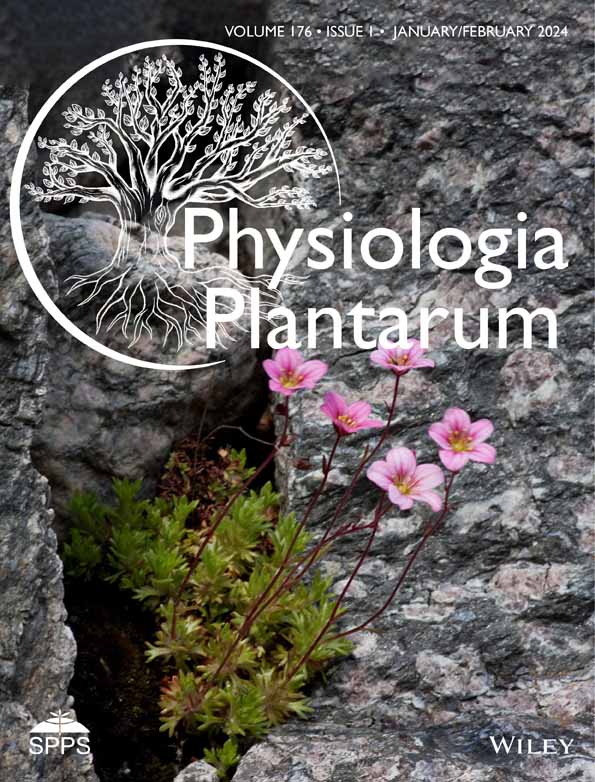Synergistic effects of melatonin and glycine betaine on seed germination, seedling growth, and biochemical attributes of maize under salinity stress
IF 5.4
2区 生物学
Q1 PLANT SCIENCES
引用次数: 0
Abstract
Salinity stress represents a major threat to crop production by inhibiting seed germination, growth of seedlings, and final yield and, therefore, to the social and economic prosperity of developing countries. Recently, plant growth‐promoting substances have been widely used as a chemical strategy for improving plant resilience towards abiotic stresses. This study aimed to determine whether melatonin (MT) and glycine betaine (GB) alone or in combination could alleviate the salinity‐induced impacts on seed germination and growth of maize seedlings. Increasing NaCl concentration from 100 to 200 mM declined seed germination rate (4.6–37.7%), germination potential (24.5–46.7%), radical length (7.7–40.0%), plumule length (2.2–35.6%), seedling fresh (1.7–41.3%) and dry weight (23.0–56.1%) compared to control (CN) plants. However, MT and GB treatments lessened the adverse effects of 100 and 150 mM NaCl and enhanced germination comparable to control plants. In addition, results from the pot experiments show that 200 mM NaCl stress disrupted the osmotic balance and persuaded oxidative stress, presented by higher electrolyte leakage, hydrogen peroxide, superoxide radicals, and malondialdehyde compared to control plants. However, compared to the NaCl treatment, NaCl+MT+GB treatment decreased the accumulation of malondialdehyde (24.2–42.1%), hydrogen peroxide (36.2–44.0%), and superoxide radicals (20.1–50.9%) by up‐regulating the activity of superoxide dismutase (28.4–51.2%), catalase (82.2–111.5%), ascorbate peroxidase (40.3–59.2%), and peroxidase (62.2–117.9%), and by enhancing osmolytes accumulation, thereby reducing NaCl‐induced oxidative damages. Based on these findings, the application of MT+GB is an efficient chemical strategy for improving seed germination and growth of seedlings by improving the physiological and biochemical attributes of maize under 200 mM NaCl stress.褪黑素和甘氨酸甜菜碱对盐胁迫下玉米种子萌发、幼苗生长和生化属性的协同效应
盐分胁迫会抑制种子发芽、幼苗生长和最终产量,从而对作物生产构成重大威胁,并因此影响发展中国家的社会和经济繁荣。近年来,植物生长促进物质作为一种化学策略被广泛应用于提高植物对非生物胁迫的抗逆性。本研究旨在确定褪黑素(MT)和甘氨酸甜菜碱(GB)单独或联合使用能否减轻盐分对玉米幼苗种子萌发和生长的影响。与对照(CN)植株相比,NaCl 浓度从 100 mM 增加到 200 mM 会降低种子发芽率(4.6-37.7%)、发芽势(24.5-46.7%)、胚根长度(7.7-40.0%)、胚珠长度(2.2-35.6%)、幼苗鲜重(1.7-41.3%)和干重(23.0-56.1%)。然而,MT 和 GB 处理减轻了 100 和 150 mM NaCl 的不利影响,并提高了发芽率,与对照植物相当。此外,盆栽实验结果表明,与对照植物相比,200 毫摩尔 NaCl 胁迫破坏了渗透平衡并导致氧化胁迫,表现为更高的电解质渗漏、过氧化氢、超氧自由基和丙二醛。然而,与 NaCl 处理相比,NaCl+MT+GB 处理通过上调超氧化物歧化酶(28.4-51.2%)、过氧化氢(36.2-44.0%)和超氧自由基(20.1-50.9%)的活性,减少了丙二醛(24.2-42.1%)、过氧化氢(36.2-44.0%)和超氧自由基(20.1-50.9%)的积累。4-51.2%)、过氧化氢酶(82.2-111.5%)、抗坏血酸过氧化物酶(40.3-59.2%)和过氧化物酶(62.2-117.9%)的活性,并增强渗透溶质的积累,从而减少氯化钠诱导的氧化损伤。基于这些发现,在 200 毫摩尔 NaCl 胁迫下,应用 MT+GB 是通过改善玉米生理生化属性来提高种子萌发和幼苗生长的一种有效化学策略。
本文章由计算机程序翻译,如有差异,请以英文原文为准。
求助全文
约1分钟内获得全文
求助全文
来源期刊

Physiologia plantarum
生物-植物科学
CiteScore
11.00
自引率
3.10%
发文量
224
审稿时长
3.9 months
期刊介绍:
Physiologia Plantarum is an international journal committed to publishing the best full-length original research papers that advance our understanding of primary mechanisms of plant development, growth and productivity as well as plant interactions with the biotic and abiotic environment. All organisational levels of experimental plant biology – from molecular and cell biology, biochemistry and biophysics to ecophysiology and global change biology – fall within the scope of the journal. The content is distributed between 5 main subject areas supervised by Subject Editors specialised in the respective domain: (1) biochemistry and metabolism, (2) ecophysiology, stress and adaptation, (3) uptake, transport and assimilation, (4) development, growth and differentiation, (5) photobiology and photosynthesis.
 求助内容:
求助内容: 应助结果提醒方式:
应助结果提醒方式:


